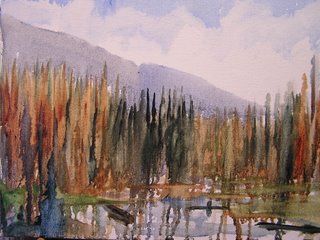
Tearing out an old restaurant to build a studio I took a few digital snaps of the work going on and found this wonderful abstraction. This was an accident. Today I'll look at it deliberately.
Twas thinking about the process of abstraction and how I would treat such a subject as this photo. The effort is congruent with my thoughts regarding the picture as an artifact. This isn't so much a 'new' thought, I am sure this has been the subject of much of modern arts efforts but it hasn't happened with me until now. Should I use materials from the subject itself? Should I see what can be done inside the computer? That's always fun and such immediate gratification.
What does an abstract Plein Air painting look like? Wolf Kahn comes to mind. It is evidently unconventional.
I visit all the pleinair sites that are cropping up and I find a number of tenets. 1. painting outside in front of the subject is the common denominator. 2. there are rules such as a time frame to be finished, usually so the works can be offered to the public. 3. most pleinair work is quite conventional with little interest in abstraction, perhaps this is to celebrate the old value of the artist as the magician that can reflect nature and astound us with the illusion of reality. One of the features or art that I highly regard. Art/artisan/artifice/artificial.............4. there are rules, rules of the event, rules of engagement and rules of authenticity although unlike improptu acting, it's OK (snicker) to work on it a bit in the studio. Whenever I am subject to rules I get in trouble. I've never had to much luck with rules and hoped I could avoid as much of that as possible.
So why am I stuck on conventional Pleinair? It's good and builds skill to try to replicate nature. Like playing a guitar and writing a song whenever an artist is involved the unexpected can happen and takes us out of the ordinary we are so used to. Even a pleinair painting has the ability to be a special artifact. One that relates, projects and elevates the viewer.
Given so much literal rendering, what part of my work should be developed in such a way as to accomplish an abstract plein air painting? Loosen up and use the imagination. Try to SEE.

